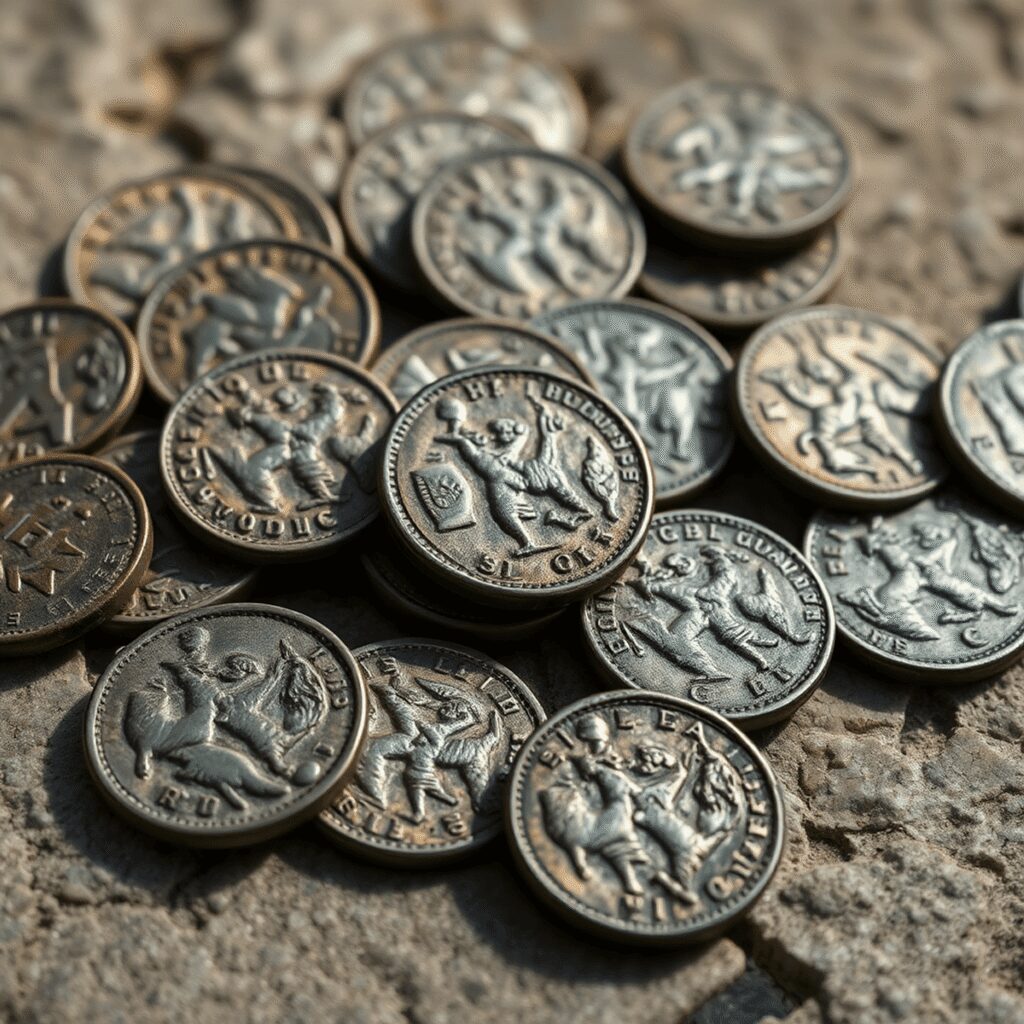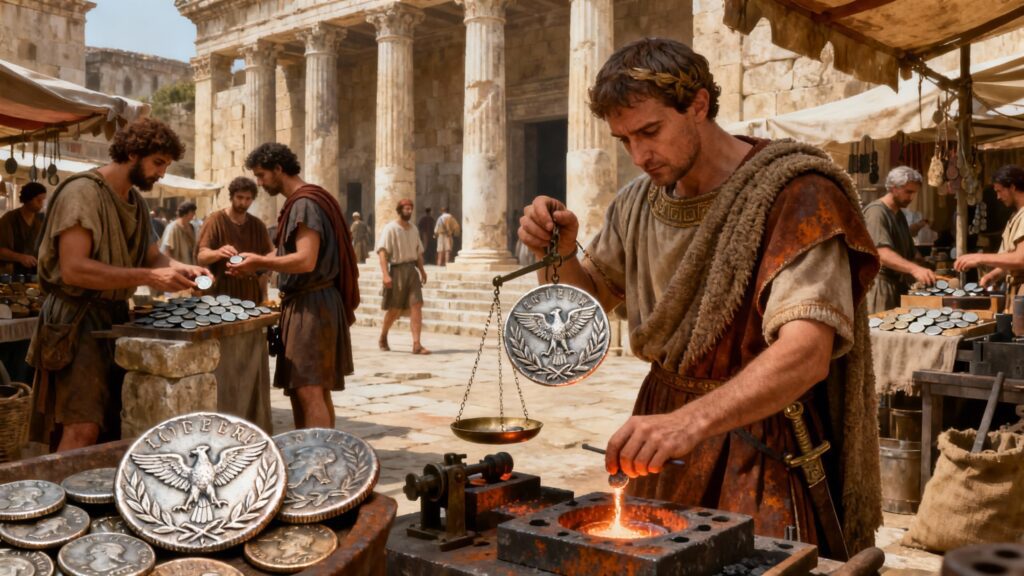The Roman Empire established one of the most sophisticated and standardized coinage systems in the ancient world. This system was crucial for facilitating trade, paying soldiers, and maintaining economic stability across vast territories. Understanding the trade and economy in Ancient Rome reveals the significance of economic practices that shaped one of history’s most powerful civilizations.
However, Roman currency counterfeiting emerged as a significant issue early on, threatening the integrity of this monetary framework. As counterfeit crime grew more common, it challenged the empire’s ability to control its economy and enforce trust in its currency.
Understanding Roman currency counterfeiting: crime, punishment, and economic impact reveals how counterfeiters operated, the detection methods used by officials, and the harsh penalties imposed to deter fraud. These aspects provide valuable insights into the difficulties faced by ancient Rome in safeguarding its coinage system. The consequences of counterfeit coins went beyond criminal acts—they had far-reaching effects on public trust and economic stability throughout the empire.
These issues were further exacerbated by political instability and weak leadership, which served as a stark reminder of how such factors can undermine even the most powerful civilizations.
In this context, it’s also worth noting the enduring influence of Roman law on modern legal systems, which reflects the complexity and sophistication of their legal framework. Furthermore, understanding the Roman Pantheon provides insights into how their beliefs and customs influenced various aspects of life, including their approach to trade and economy.
The Roman Coinage System and Its Vulnerabilities
The Roman coinage system was a cornerstone of the empire’s economic power. It relied on standardized currency that enabled efficient trade across vast territories. Coins such as the denarius, aureus, and sestertius were minted with consistent weight, metal content, and intricate designs. This uniformity fostered trust among merchants, citizens, and provincial authorities, facilitating commerce and tax collection.
However, the economic power of Rome was not solely dependent on its coinage system. The Roman society was deeply intertwined with religious practices that often influenced its economy. For instance, rituals and sacrifices were an integral part of how Romans connected with their gods, which in turn affected their economic activities and coin usage.
Vulnerabilities in the Coinage System
Despite its sophistication, the coinage system exhibited clear coinage vulnerabilities starting in the 3rd century BCE. Early signs of weakness appeared as counterfeiters exploited gaps in minting controls. For instance:
- Imperfect weight standards created opportunities for underweight coins to circulate unnoticed.
- Simplified designs during periods of rapid expansion reduced the complexity that deterred forgery.
- Use of mixed or debased metals weakened coins’ intrinsic value, inviting imitation with cheaper alloys.
Such vulnerabilities illustrate a common challenge in monetary systems: balancing ease of production with security features that prevent fraud. Roman authorities recognized these threats but often struggled to keep pace with counterfeiters’ evolving techniques.
Importance of Identifying Weaknesses
Identifying weaknesses in any currency system remains crucial. Without proactive measures, even a highly standardized coinage can be undermined by fake currency, eroding public confidence and destabilizing economies. Rome’s experience underscores the need for constant vigilance and adaptation in safeguarding monetary integrity—a lesson that resonates beyond antiquity.

Methods of Counterfeiting in Ancient Rome
Counterfeit methods in ancient Rome were surprisingly sophisticated, reflecting the high stakes involved in producing Roman fake coins. One common technique involved coin molds—crafting impressions from genuine coins to create duplicates by pouring molten metal into these molds. This approach allowed counterfeiters to replicate the general shape and some surface details but often fell short on precision.
Another prevalent method was silver and gold plating, where base metal cores were coated with thin layers of precious metals. This gave fake coins a convincing appearance of authenticity when viewed superficially or weighed lightly. The plated coins could deceive casual handlers but generally failed under close scrutiny due to inconsistencies in weight and texture.
Challenges Faced by Counterfeiters
Challenges faced by counterfeiters extended beyond mere visual imitation. Roman coins featured intricate designs, precise inscriptions, and specific weight standards. Replicating these details required skill and access to resources, which many counterfeiters lacked. For example:
- Intricate design replication: Official coins bore finely detailed portraits, symbols, and lettering that were difficult to duplicate without specialized tools.
- Weight accuracy: Genuine coins adhered to strict weight requirements tied to their metal content. Counterfeit coins frequently deviated from these norms, making them susceptible to detection.
- Surface texture: The feel of the coin’s surface—its smoothness, relief depth, and metallic sheen—was another hurdle for counterfeiters attempting to mimic official issues.
The combination of these factors meant counterfeiters often produced low-quality fakes aimed at quick profit rather than long-term circulation. Despite their efforts, many fake coins lacked the durability and fidelity necessary to pass rigorous inspections carried out by Roman officials.
The influence of Roman society on Western civilization is profound, as seen in various aspects such as legal systems and architectural marvels. This legacy continues to shape contemporary society, highlighting the importance of understanding the historical context behind such practices like counterfeiting which were part of the larger socio-economic fabric of ancient Rome.
Detection and Inspection: The Role of Veritores
Veritores were specialized officials appointed within the imperial mints and throughout Roman marketplaces to carry out rigorous authenticity checks on circulating coinage. Their role was critical in the fight against counterfeit currency, serving as a frontline defense to maintain trust in the Roman monetary system.
Veritores employed a set of meticulous inspection methods designed to detect even the most skillfully produced fake coins. These criteria included:
- Weight measurements: Genuine Roman coins had strict weight standards tied to their denomination and metal content. Veritores used precise scales to verify that coins matched expected weights, identifying counterfeit coins that were often lighter due to inferior metals or hollow casting.
- Design accuracy assessments: Official coins bore detailed imagery, inscriptions, and iconography authorized by the state. Veritores examined these features closely for deviations such as blurred details, incorrect lettering styles, or inconsistent portraits which indicated forgery.
- Surface texture evaluations: The feel and finish of a coin’s surface provided clues about its authenticity. Genuine coins showed uniform metal composition and well-struck reliefs, while counterfeit pieces sometimes exhibited uneven surfaces, rough edges, or suspicious plating.
These inspections took place not only within mint facilities but also in public markets and trade centers where coin circulation was high. By enforcing such stringent checks, veritores helped limit the spread of counterfeit currency and bolstered economic confidence during periods when Roman Currency Counterfeiting: Crime, Punishment, and Economic Impact posed significant threats.
The presence of veritores underscored the empire’s commitment to monetary integrity through constant vigilance against forgery. This system of official inspection complemented legal deterrents and technical reforms aimed at protecting Rome’s financial stability.

Legal Consequences and Punishments for Counterfeiters
Roman law enforcement treated counterfeiting as a serious crime that threatened the empire’s economic stability. Punishments for counterfeiting were severe and intended to discourage forgery.
Severity of penalties included:
- Hefty fines: Offenders faced substantial monetary penalties aimed at compensating losses caused by fake currency.
- Public flogging: Physical punishment was common, serving both as retribution and public spectacle to discourage others.
- Imprisonment: Some counterfeiters endured incarceration under harsh conditions, reflecting the seriousness of their crime.
- Death by crucifixion: The ultimate penalty reserved for repeat offenders or large-scale counterfeiters. This brutal form of execution underscored the state’s zero-tolerance policy towards undermining its monetary system.
The rationale behind these strict punishments centered on protecting public trust in Roman coinage. Counterfeit coins endangered commerce and government revenue, so authorities sought to eliminate forgery swiftly and decisively. Harsh penalties reinforced the message that tampering with currency was not merely a financial crime but an attack on imperial order itself.
Roman legal codes explicitly criminalized counterfeiting, ensuring that those caught faced immediate legal consequences without leniency. This strict approach reflected recognition that economic security depended heavily on maintaining confidence in the authenticity of money circulating throughout the empire.
By imposing such severe sanctions, Roman officials aimed to suppress forgery attempts effectively and preserve the integrity of their sophisticated coinage system.
The Economic Impact of Counterfeit Currency on the Roman Empire
Counterfeit currency severely compromised the Roman economy by eroding public trust in the value and authenticity of coinage. When fake coins flooded the market, individuals and merchants became increasingly skeptical about accepting currency, questioning whether coins in circulation held their stated worth. This erosion of confidence made everyday transactions more difficult and slowed commercial activity.
Key economic repercussions included:
- Inflation in Rome: Counterfeit coins diluted the precious metal content of genuine currency, effectively increasing the money supply without a corresponding growth in goods or services. This imbalance triggered inflationary pressures as prices rose to compensate for the devalued money.
- Trade Disruption: Traders relied heavily on standardized coinage to facilitate commerce across vast regions. The presence of counterfeit coins introduced uncertainty, forcing merchants to test or reject coins, which impeded smooth trade exchanges both locally and throughout the empire.
- Currency System Instability: The integrity of Roman currency was central to maintaining economic order. Widespread counterfeiting destabilized this foundation, undermining efforts by authorities to maintain consistent monetary policy and control over fiscal matters.
“The widespread circulation of counterfeit coins did not just represent a criminal offense; it struck at the heart of Rome’s economic stability.”
The ripple effects extended beyond immediate financial losses. Inflation reduced purchasing power for citizens, impacting soldiers’ pay—an issue considering the power and strategy of the Roman military, which was largely funded through such coinage—and government revenues dependent on taxation through coinage. Economic volatility prompted authorities to continuously reform coin designs and enforce stricter penalties to restore confidence.
Examining Roman Currency Counterfeiting: Crime from an economic perspective reveals how crucial maintaining a trusted currency was for sustaining one of history’s largest empires. Preventing counterfeiting went beyond law enforcement—it was essential for protecting Rome’s financial health and its expansive trade networks.
Interestingly, these coins were not just a medium of exchange but also served as propaganda tools that conveyed political messages and authority from emperors. Moreover, the artistic designs on these coins reflect the masterpieces of Roman art, showcasing the empire’s vast reach and its ability to assimilate and innovate across various cultures.
Government Measures to Combat Counterfeiting
The Roman authorities implemented a range of anti-counterfeiting reforms designed to protect the integrity of their currency. These measures focused on making coin forgery increasingly difficult and risky for counterfeiters.
Continuous Reforms in Coin Design
The Roman government regularly updated coin designs, introducing more intricate imagery and detailed inscriptions. Complex portraits of emperors and symbolic motifs served as authentication markers. These evolving designs required counterfeiters to constantly adapt, raising the technical barrier for producing convincing fakes.
Metal Composition Adjustments
Authorities manipulated the alloy content of coins, balancing precious metals such as silver or gold with base metals like copper. By carefully controlling the metal ratios, genuine coins maintained consistent weight and color characteristics that were hard to replicate exactly. This approach acted as a deterrent since counterfeiters struggled to source appropriate materials and match official metal standards.
Mint Security Measures
Strict oversight was enforced at mints to limit internal collusion and theft. Officials known as monetarii managed mint operations under close supervision, while appointed inspectors (veritores) conducted regular checks on production quality. Mints employed physical safeguards such as sealed storage for precious metals and restricted access areas within facilities.
Use of Edge Inscriptions and Markings
Some Roman coins featured edge lettering or distinct ridges that complicated counterfeiting attempts. These fine details required specialized equipment to reproduce accurately, adding another layer of protection against forgery.
These combined efforts formed a multi-faceted defense system that evolved alongside the sophistication of counterfeiters. The Roman Empire’s persistent focus on improving coin security reflected an acute awareness of how vital monetary trust was to economic stability—an insight still relevant today.

Effectiveness Assessment: Roman Anti-Counterfeiting Strategies Under Scrutiny
The Roman Empire’s approach to combating counterfeit currency combined vigilant inspection by veritores with strict legal enforcement. This dual strategy proved critical in mitigating the economic damage caused by counterfeit coins during various historical periods.
Key factors influencing enforcement success stories include:
Consistent Monitoring: Veritores regularly examined circulating coins, focusing on weight accuracy and design fidelity. Their presence acted as a constant deterrent against counterfeit circulation.
Legal Severity: Harsh punishments such as fines, imprisonment, and crucifixion sent a clear message that counterfeiting was a crime met with zero tolerance. These penalties discouraged potential counterfeiters despite the risks involved in illicit minting.
Adaptive Reforms: Continuous updates to coin designs and metal compositions made it increasingly difficult for counterfeiters to replicate official currency effectively. The incorporation of edge inscriptions served as an additional authenticity marker.
Instances where these measures aligned demonstrated tangible reductions in counterfeit prevalence. For example, during the reign of Emperor Augustus, strict mint controls and severe legal consequences led to a notable decline in forged coins disrupting commerce. Similarly, later imperial efforts under Diocletian introduced systematic reforms that fortified both inspection rigor and punitive measures.
Challenges persisted, especially during times of political instability or economic crisis when enforcement resources weakened. Still, the combination of administrative vigilance and uncompromising legal frameworks laid a foundation for maintaining monetary integrity against counterfeiting threats across centuries.
Interestingly, the same period also witnessed significant advancements in Roman sculpture, which not only reflected the cultural and social dynamics of ancient Rome but also served as instruments for political propaganda. This evolution in art showcased a distinct focus on realism and the portrayal of power, paralleling the stringent measures taken against counterfeiting which aimed to preserve the integrity of Roman currency.
Conclusion
The story of Roman Currency Counterfeiting: Crime, Punishment, and Economic Impact offers more than just a historical account; it reveals important lessons that are relevant to today’s monetary systems. The Roman Empire’s fight against counterfeit currency highlights critical themes:
- The necessity of strong inspection methods like the veritores to ensure coin authenticity.
- The crucial role of severe legal punishments in preventing fraudulent activities.
- Continuous adaptation in coin design and composition as a key defense against evolving counterfeit techniques.
These elements reflect timeless principles essential for maintaining trust in any currency. Understanding these ancient economic challenges gives you insight into how monetary integrity relies on vigilance, innovation, and enforcement. Modern economies face similar threats from counterfeiting, making the Roman experience a valuable reference point.
Protecting currency is not just a technical issue but a fundamental pillar supporting economic trust and stability—an idea deeply rooted in the legacy of Rome’s fight against counterfeiters.
FAQs (Frequently Asked Questions)
What was the Roman coinage system and why was it vulnerable to counterfeiting?
The Roman coinage system was a sophisticated and standardized currency system that facilitated trade and economic stability across the empire. However, from the 3rd century BCE onward, vulnerabilities emerged due to the complexity of coin designs and metal compositions, making it susceptible to counterfeit currency which threatened monetary integrity.
How did counterfeiters create fake Roman coins in ancient times?
Ancient Roman counterfeiters employed various methods such as using molds to cast fake coins and applying thin layers of silver or gold plating over base metals to mimic authentic coins. Despite these techniques, replicating the intricate designs and precise weight specifications of official coins posed significant challenges.
Who were the veritores and what role did they play in detecting counterfeit Roman currency?
Veritores were appointed officials responsible for inspecting circulating coins to ensure their authenticity. They conducted thorough checks involving weight measurements, design accuracy assessments, and surface texture evaluations, playing a critical role in maintaining trust in the Roman monetary system.
What legal consequences did counterfeiters face in ancient Rome?
Individuals caught counterfeiting Roman currency faced severe punishments under Roman law, ranging from hefty fines to death by crucifixion. These harsh penalties served as strong deterrents aimed at protecting the empire’s economic stability from fraudulent practices.
How did counterfeit currency impact the economy of the Roman Empire?
The widespread circulation of counterfeit coins undermined public trust in the integrity of the Roman currency system, disrupted trade, and contributed to inflationary pressures within the empire. This economic impact challenged Rome’s ability to maintain a stable and reliable monetary environment.
What measures did the Roman government implement to combat currency counterfeiting?
Roman authorities employed various anti-counterfeiting strategies including continuous reforms in coin design and metal composition to deter counterfeiters. Enhanced mint security measures and vigilant inspections by veritores also helped mitigate economic damage caused by counterfeit currency throughout different periods of Roman history.

